Lush Cosmetics: A Report on Global Market Expansion and Strategies
VerifiedAdded on 2022/08/26
|13
|3700
|17
Report
AI Summary
This report provides a comprehensive analysis of Lush Cosmetics' potential for international market expansion. It begins by identifying Malaysia, India, and Argentina as key markets, offering insights into cultural differentiation and the importance of understanding local consumer preferences. The report advocates for in-house production to ensure quality control and flexibility. It also suggests strategic distribution through transport hubs like airports and railway stations to reach a diverse customer base. Furthermore, it details promotional strategies, including social media campaigns and discounts, and emphasizes the need for market research and adaptation to local tastes. The report also explores the Ansoff Matrix, highlighting market penetration and development strategies, and concludes with a discussion on the marketing mix, including product, price, place, and promotion considerations, to facilitate successful market entry and growth.
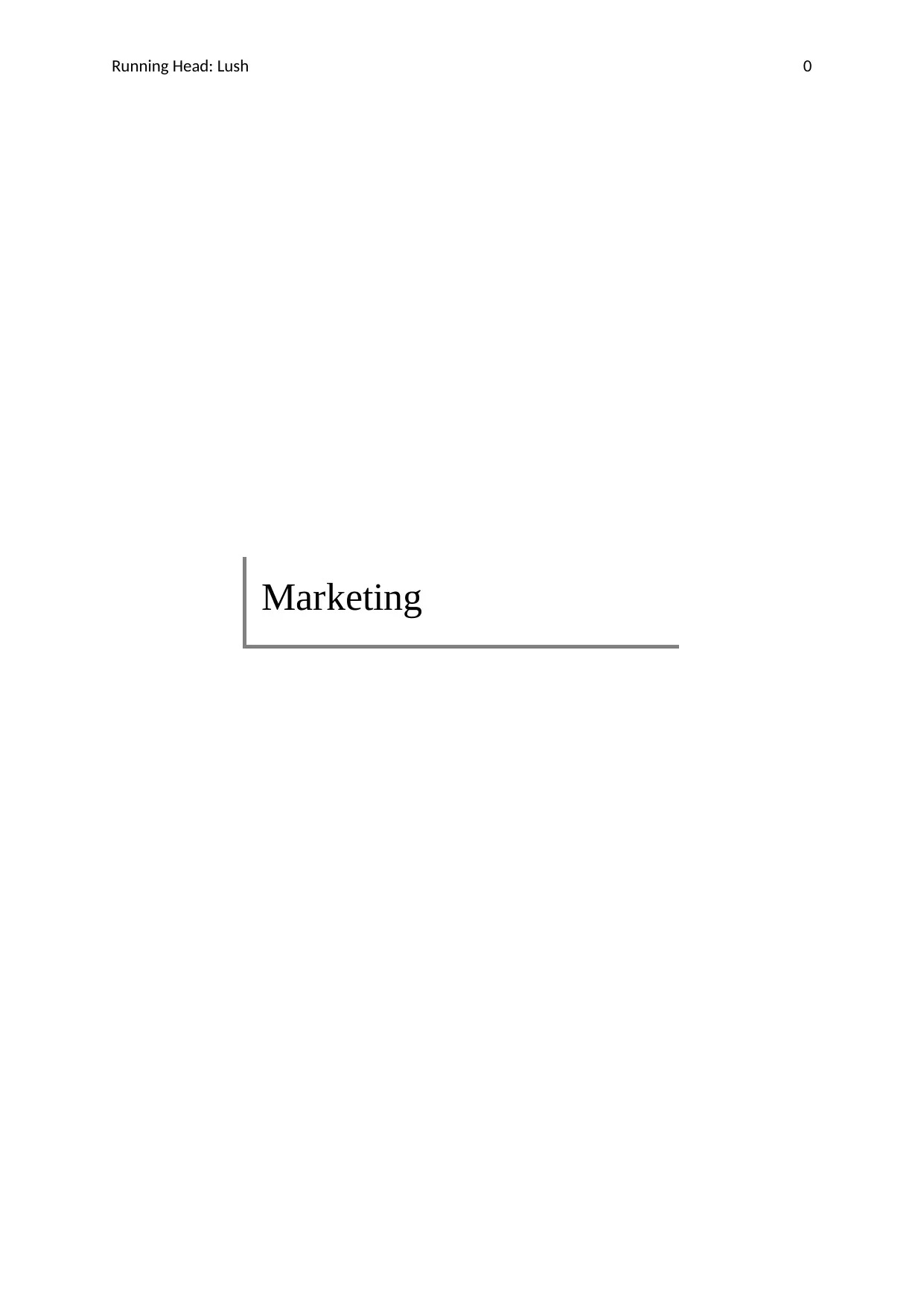
Running Head: Lush 0
Marketing
Marketing
Paraphrase This Document
Need a fresh take? Get an instant paraphrase of this document with our AI Paraphraser
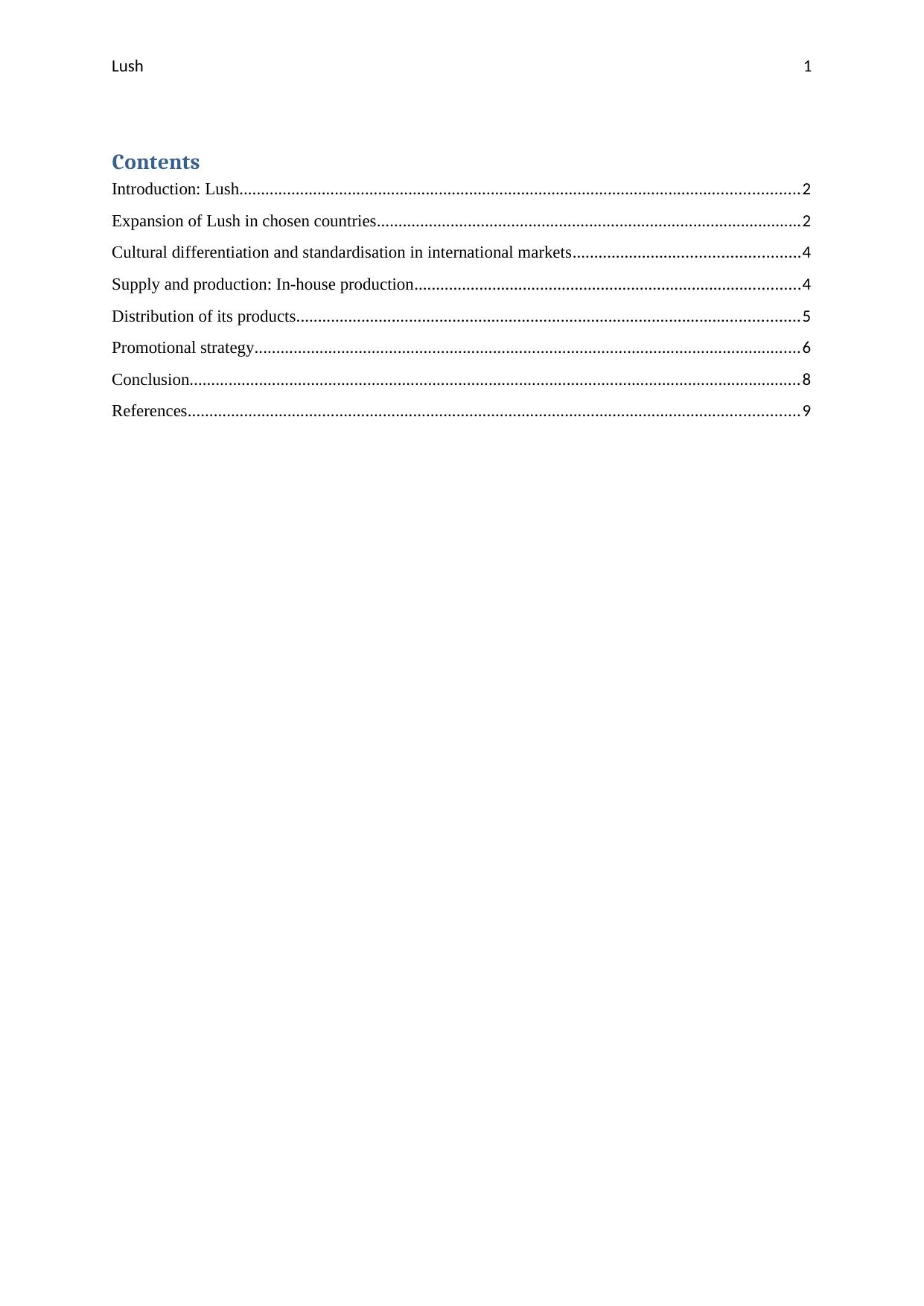
Lush 1
Contents
Introduction: Lush.................................................................................................................................2
Expansion of Lush in chosen countries..................................................................................................2
Cultural differentiation and standardisation in international markets....................................................4
Supply and production: In-house production.........................................................................................4
Distribution of its products....................................................................................................................5
Promotional strategy..............................................................................................................................6
Conclusion.............................................................................................................................................8
References.............................................................................................................................................9
Contents
Introduction: Lush.................................................................................................................................2
Expansion of Lush in chosen countries..................................................................................................2
Cultural differentiation and standardisation in international markets....................................................4
Supply and production: In-house production.........................................................................................4
Distribution of its products....................................................................................................................5
Promotional strategy..............................................................................................................................6
Conclusion.............................................................................................................................................8
References.............................................................................................................................................9
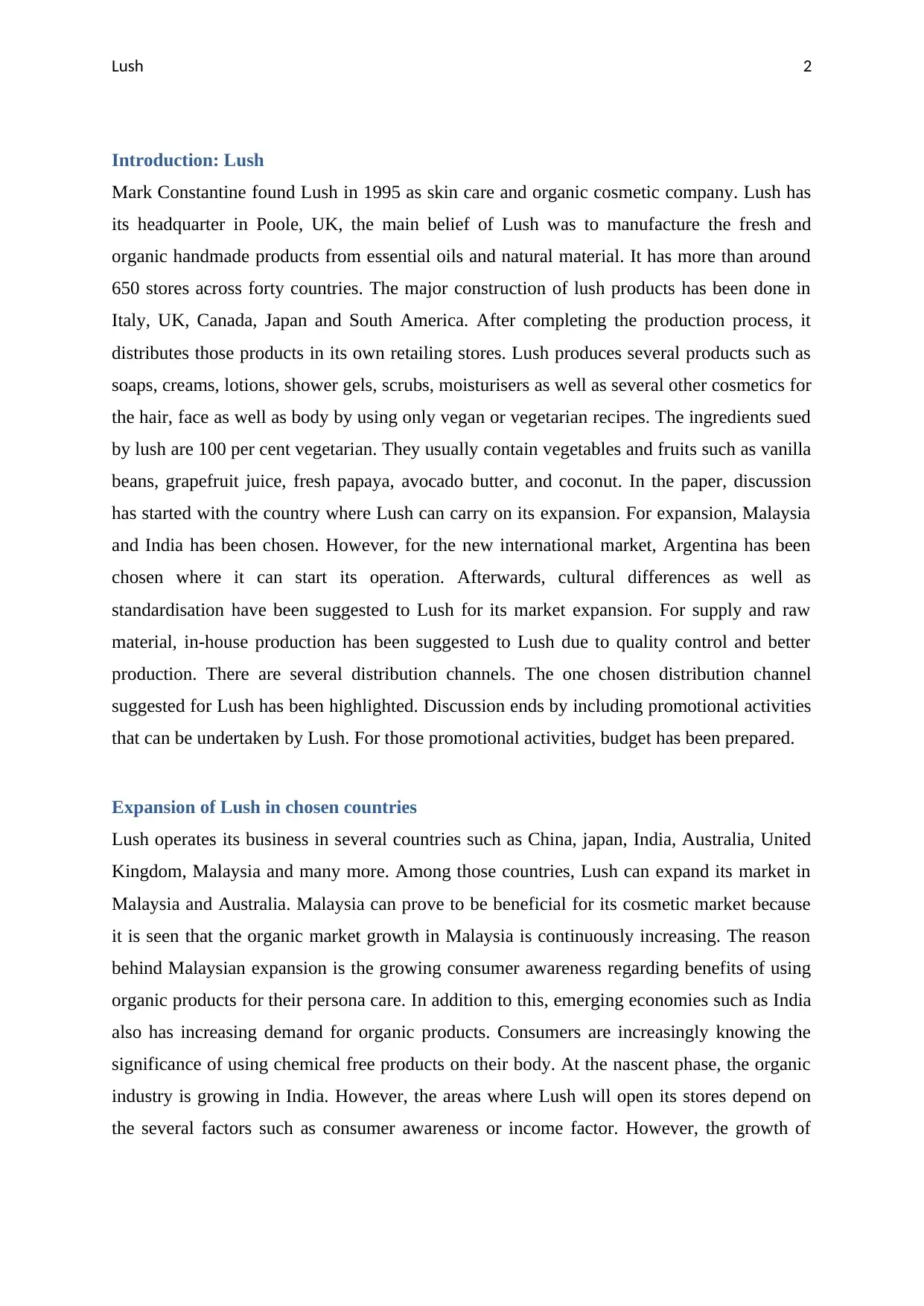
Lush 2
Introduction: Lush
Mark Constantine found Lush in 1995 as skin care and organic cosmetic company. Lush has
its headquarter in Poole, UK, the main belief of Lush was to manufacture the fresh and
organic handmade products from essential oils and natural material. It has more than around
650 stores across forty countries. The major construction of lush products has been done in
Italy, UK, Canada, Japan and South America. After completing the production process, it
distributes those products in its own retailing stores. Lush produces several products such as
soaps, creams, lotions, shower gels, scrubs, moisturisers as well as several other cosmetics for
the hair, face as well as body by using only vegan or vegetarian recipes. The ingredients sued
by lush are 100 per cent vegetarian. They usually contain vegetables and fruits such as vanilla
beans, grapefruit juice, fresh papaya, avocado butter, and coconut. In the paper, discussion
has started with the country where Lush can carry on its expansion. For expansion, Malaysia
and India has been chosen. However, for the new international market, Argentina has been
chosen where it can start its operation. Afterwards, cultural differences as well as
standardisation have been suggested to Lush for its market expansion. For supply and raw
material, in-house production has been suggested to Lush due to quality control and better
production. There are several distribution channels. The one chosen distribution channel
suggested for Lush has been highlighted. Discussion ends by including promotional activities
that can be undertaken by Lush. For those promotional activities, budget has been prepared.
Expansion of Lush in chosen countries
Lush operates its business in several countries such as China, japan, India, Australia, United
Kingdom, Malaysia and many more. Among those countries, Lush can expand its market in
Malaysia and Australia. Malaysia can prove to be beneficial for its cosmetic market because
it is seen that the organic market growth in Malaysia is continuously increasing. The reason
behind Malaysian expansion is the growing consumer awareness regarding benefits of using
organic products for their persona care. In addition to this, emerging economies such as India
also has increasing demand for organic products. Consumers are increasingly knowing the
significance of using chemical free products on their body. At the nascent phase, the organic
industry is growing in India. However, the areas where Lush will open its stores depend on
the several factors such as consumer awareness or income factor. However, the growth of
Introduction: Lush
Mark Constantine found Lush in 1995 as skin care and organic cosmetic company. Lush has
its headquarter in Poole, UK, the main belief of Lush was to manufacture the fresh and
organic handmade products from essential oils and natural material. It has more than around
650 stores across forty countries. The major construction of lush products has been done in
Italy, UK, Canada, Japan and South America. After completing the production process, it
distributes those products in its own retailing stores. Lush produces several products such as
soaps, creams, lotions, shower gels, scrubs, moisturisers as well as several other cosmetics for
the hair, face as well as body by using only vegan or vegetarian recipes. The ingredients sued
by lush are 100 per cent vegetarian. They usually contain vegetables and fruits such as vanilla
beans, grapefruit juice, fresh papaya, avocado butter, and coconut. In the paper, discussion
has started with the country where Lush can carry on its expansion. For expansion, Malaysia
and India has been chosen. However, for the new international market, Argentina has been
chosen where it can start its operation. Afterwards, cultural differences as well as
standardisation have been suggested to Lush for its market expansion. For supply and raw
material, in-house production has been suggested to Lush due to quality control and better
production. There are several distribution channels. The one chosen distribution channel
suggested for Lush has been highlighted. Discussion ends by including promotional activities
that can be undertaken by Lush. For those promotional activities, budget has been prepared.
Expansion of Lush in chosen countries
Lush operates its business in several countries such as China, japan, India, Australia, United
Kingdom, Malaysia and many more. Among those countries, Lush can expand its market in
Malaysia and Australia. Malaysia can prove to be beneficial for its cosmetic market because
it is seen that the organic market growth in Malaysia is continuously increasing. The reason
behind Malaysian expansion is the growing consumer awareness regarding benefits of using
organic products for their persona care. In addition to this, emerging economies such as India
also has increasing demand for organic products. Consumers are increasingly knowing the
significance of using chemical free products on their body. At the nascent phase, the organic
industry is growing in India. However, the areas where Lush will open its stores depend on
the several factors such as consumer awareness or income factor. However, the growth of
⊘ This is a preview!⊘
Do you want full access?
Subscribe today to unlock all pages.

Trusted by 1+ million students worldwide
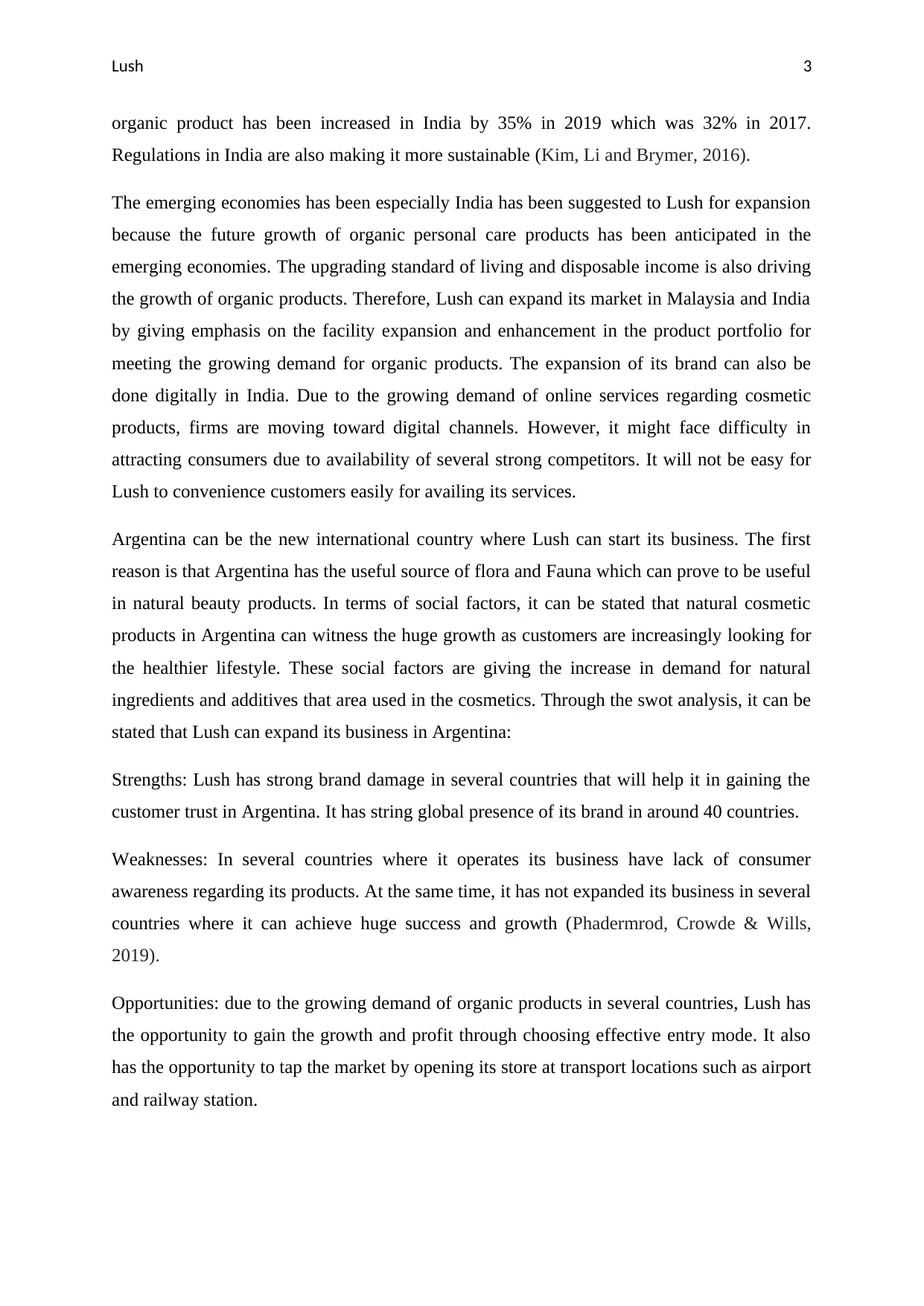
Lush 3
organic product has been increased in India by 35% in 2019 which was 32% in 2017.
Regulations in India are also making it more sustainable (Kim, Li and Brymer, 2016).
The emerging economies has been especially India has been suggested to Lush for expansion
because the future growth of organic personal care products has been anticipated in the
emerging economies. The upgrading standard of living and disposable income is also driving
the growth of organic products. Therefore, Lush can expand its market in Malaysia and India
by giving emphasis on the facility expansion and enhancement in the product portfolio for
meeting the growing demand for organic products. The expansion of its brand can also be
done digitally in India. Due to the growing demand of online services regarding cosmetic
products, firms are moving toward digital channels. However, it might face difficulty in
attracting consumers due to availability of several strong competitors. It will not be easy for
Lush to convenience customers easily for availing its services.
Argentina can be the new international country where Lush can start its business. The first
reason is that Argentina has the useful source of flora and Fauna which can prove to be useful
in natural beauty products. In terms of social factors, it can be stated that natural cosmetic
products in Argentina can witness the huge growth as customers are increasingly looking for
the healthier lifestyle. These social factors are giving the increase in demand for natural
ingredients and additives that area used in the cosmetics. Through the swot analysis, it can be
stated that Lush can expand its business in Argentina:
Strengths: Lush has strong brand damage in several countries that will help it in gaining the
customer trust in Argentina. It has string global presence of its brand in around 40 countries.
Weaknesses: In several countries where it operates its business have lack of consumer
awareness regarding its products. At the same time, it has not expanded its business in several
countries where it can achieve huge success and growth (Phadermrod, Crowde & Wills,
2019).
Opportunities: due to the growing demand of organic products in several countries, Lush has
the opportunity to gain the growth and profit through choosing effective entry mode. It also
has the opportunity to tap the market by opening its store at transport locations such as airport
and railway station.
organic product has been increased in India by 35% in 2019 which was 32% in 2017.
Regulations in India are also making it more sustainable (Kim, Li and Brymer, 2016).
The emerging economies has been especially India has been suggested to Lush for expansion
because the future growth of organic personal care products has been anticipated in the
emerging economies. The upgrading standard of living and disposable income is also driving
the growth of organic products. Therefore, Lush can expand its market in Malaysia and India
by giving emphasis on the facility expansion and enhancement in the product portfolio for
meeting the growing demand for organic products. The expansion of its brand can also be
done digitally in India. Due to the growing demand of online services regarding cosmetic
products, firms are moving toward digital channels. However, it might face difficulty in
attracting consumers due to availability of several strong competitors. It will not be easy for
Lush to convenience customers easily for availing its services.
Argentina can be the new international country where Lush can start its business. The first
reason is that Argentina has the useful source of flora and Fauna which can prove to be useful
in natural beauty products. In terms of social factors, it can be stated that natural cosmetic
products in Argentina can witness the huge growth as customers are increasingly looking for
the healthier lifestyle. These social factors are giving the increase in demand for natural
ingredients and additives that area used in the cosmetics. Through the swot analysis, it can be
stated that Lush can expand its business in Argentina:
Strengths: Lush has strong brand damage in several countries that will help it in gaining the
customer trust in Argentina. It has string global presence of its brand in around 40 countries.
Weaknesses: In several countries where it operates its business have lack of consumer
awareness regarding its products. At the same time, it has not expanded its business in several
countries where it can achieve huge success and growth (Phadermrod, Crowde & Wills,
2019).
Opportunities: due to the growing demand of organic products in several countries, Lush has
the opportunity to gain the growth and profit through choosing effective entry mode. It also
has the opportunity to tap the market by opening its store at transport locations such as airport
and railway station.
Paraphrase This Document
Need a fresh take? Get an instant paraphrase of this document with our AI Paraphraser
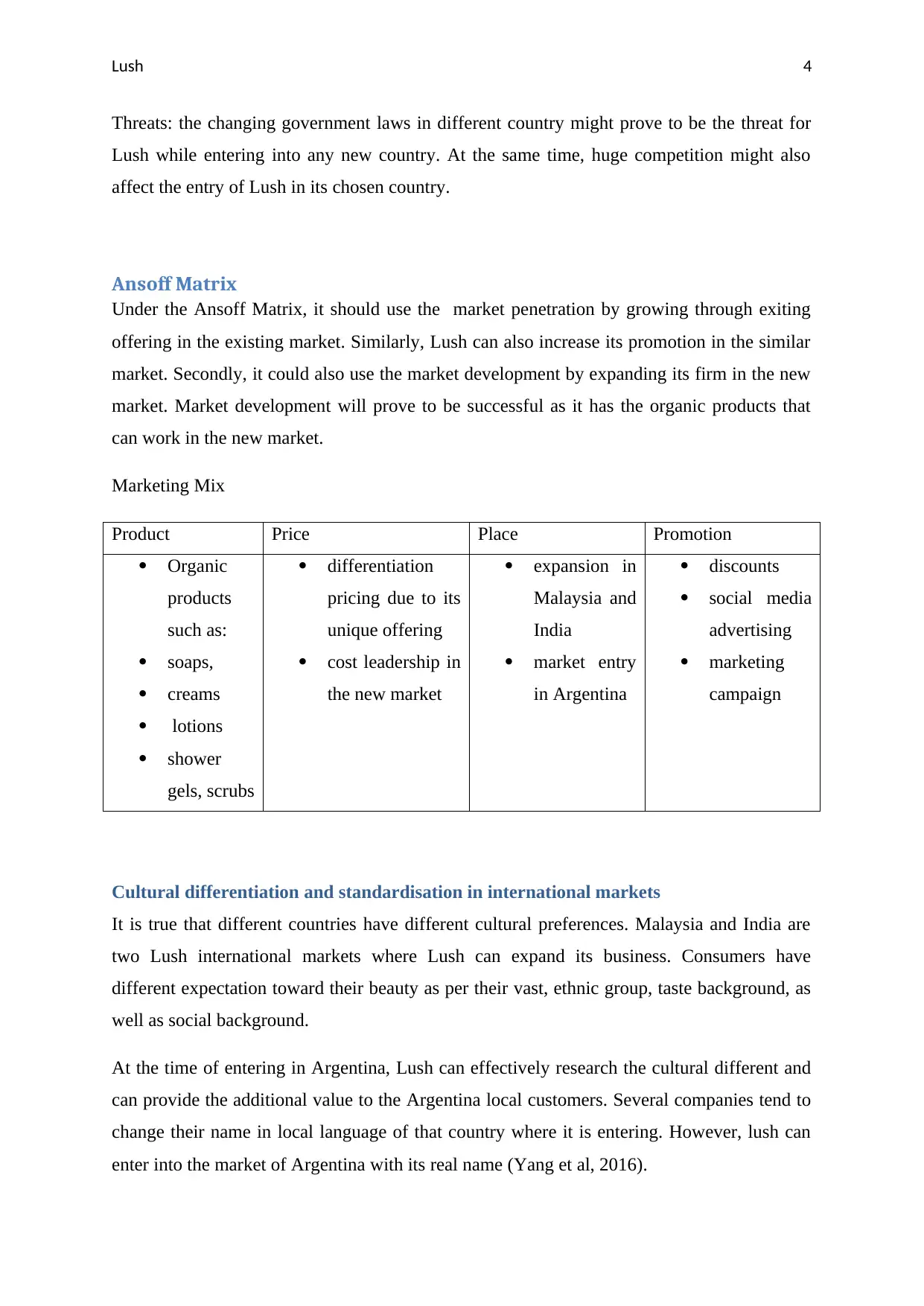
Lush 4
Threats: the changing government laws in different country might prove to be the threat for
Lush while entering into any new country. At the same time, huge competition might also
affect the entry of Lush in its chosen country.
Ansoff Matrix
Under the Ansoff Matrix, it should use the market penetration by growing through exiting
offering in the existing market. Similarly, Lush can also increase its promotion in the similar
market. Secondly, it could also use the market development by expanding its firm in the new
market. Market development will prove to be successful as it has the organic products that
can work in the new market.
Marketing Mix
Product Price Place Promotion
Organic
products
such as:
soaps,
creams
lotions
shower
gels, scrubs
differentiation
pricing due to its
unique offering
cost leadership in
the new market
expansion in
Malaysia and
India
market entry
in Argentina
discounts
social media
advertising
marketing
campaign
Cultural differentiation and standardisation in international markets
It is true that different countries have different cultural preferences. Malaysia and India are
two Lush international markets where Lush can expand its business. Consumers have
different expectation toward their beauty as per their vast, ethnic group, taste background, as
well as social background.
At the time of entering in Argentina, Lush can effectively research the cultural different and
can provide the additional value to the Argentina local customers. Several companies tend to
change their name in local language of that country where it is entering. However, lush can
enter into the market of Argentina with its real name (Yang et al, 2016).
Threats: the changing government laws in different country might prove to be the threat for
Lush while entering into any new country. At the same time, huge competition might also
affect the entry of Lush in its chosen country.
Ansoff Matrix
Under the Ansoff Matrix, it should use the market penetration by growing through exiting
offering in the existing market. Similarly, Lush can also increase its promotion in the similar
market. Secondly, it could also use the market development by expanding its firm in the new
market. Market development will prove to be successful as it has the organic products that
can work in the new market.
Marketing Mix
Product Price Place Promotion
Organic
products
such as:
soaps,
creams
lotions
shower
gels, scrubs
differentiation
pricing due to its
unique offering
cost leadership in
the new market
expansion in
Malaysia and
India
market entry
in Argentina
discounts
social media
advertising
marketing
campaign
Cultural differentiation and standardisation in international markets
It is true that different countries have different cultural preferences. Malaysia and India are
two Lush international markets where Lush can expand its business. Consumers have
different expectation toward their beauty as per their vast, ethnic group, taste background, as
well as social background.
At the time of entering in Argentina, Lush can effectively research the cultural different and
can provide the additional value to the Argentina local customers. Several companies tend to
change their name in local language of that country where it is entering. However, lush can
enter into the market of Argentina with its real name (Yang et al, 2016).
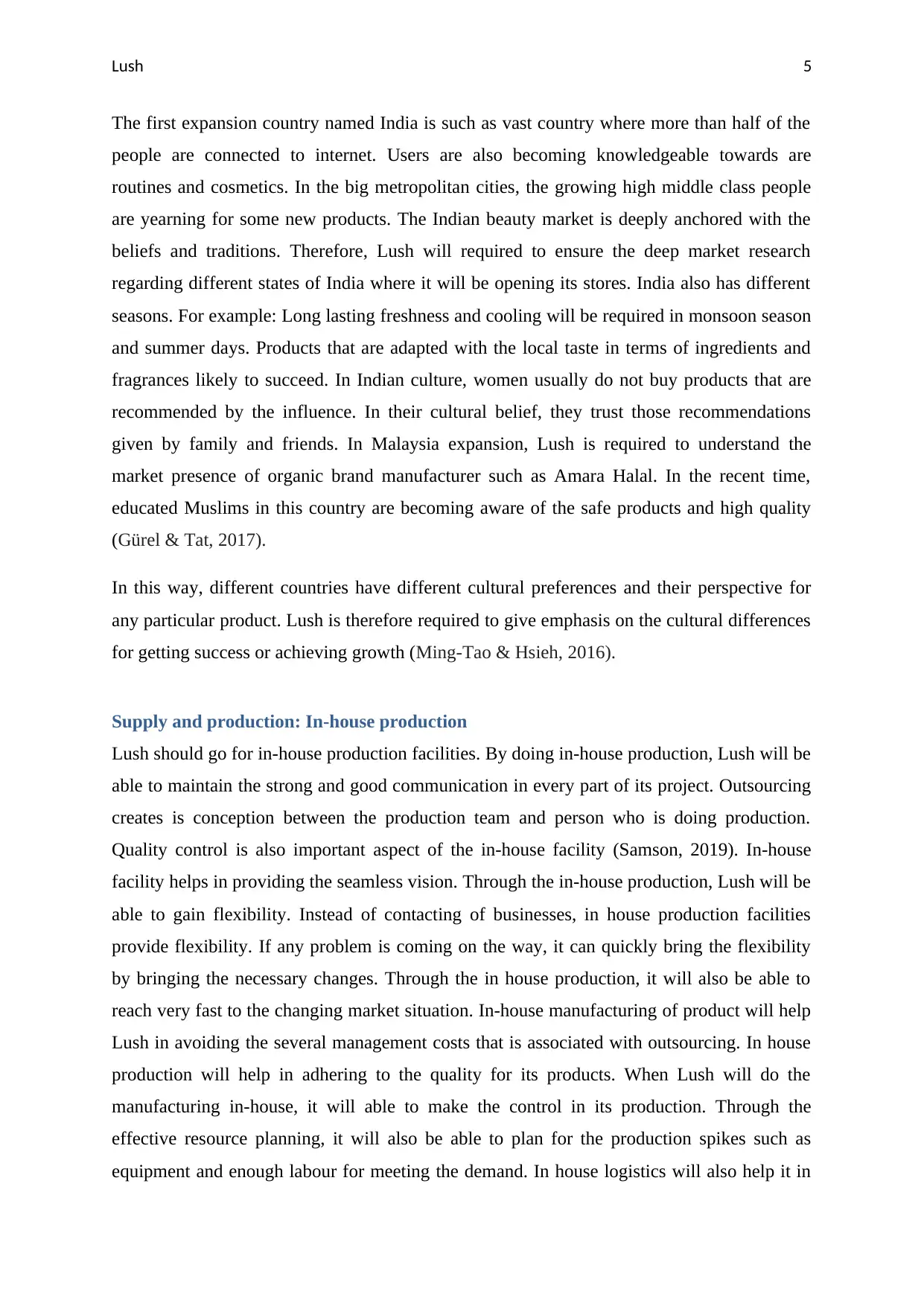
Lush 5
The first expansion country named India is such as vast country where more than half of the
people are connected to internet. Users are also becoming knowledgeable towards are
routines and cosmetics. In the big metropolitan cities, the growing high middle class people
are yearning for some new products. The Indian beauty market is deeply anchored with the
beliefs and traditions. Therefore, Lush will required to ensure the deep market research
regarding different states of India where it will be opening its stores. India also has different
seasons. For example: Long lasting freshness and cooling will be required in monsoon season
and summer days. Products that are adapted with the local taste in terms of ingredients and
fragrances likely to succeed. In Indian culture, women usually do not buy products that are
recommended by the influence. In their cultural belief, they trust those recommendations
given by family and friends. In Malaysia expansion, Lush is required to understand the
market presence of organic brand manufacturer such as Amara Halal. In the recent time,
educated Muslims in this country are becoming aware of the safe products and high quality
(Gürel & Tat, 2017).
In this way, different countries have different cultural preferences and their perspective for
any particular product. Lush is therefore required to give emphasis on the cultural differences
for getting success or achieving growth (Ming-Tao & Hsieh, 2016).
Supply and production: In-house production
Lush should go for in-house production facilities. By doing in-house production, Lush will be
able to maintain the strong and good communication in every part of its project. Outsourcing
creates is conception between the production team and person who is doing production.
Quality control is also important aspect of the in-house facility (Samson, 2019). In-house
facility helps in providing the seamless vision. Through the in-house production, Lush will be
able to gain flexibility. Instead of contacting of businesses, in house production facilities
provide flexibility. If any problem is coming on the way, it can quickly bring the flexibility
by bringing the necessary changes. Through the in house production, it will also be able to
reach very fast to the changing market situation. In-house manufacturing of product will help
Lush in avoiding the several management costs that is associated with outsourcing. In house
production will help in adhering to the quality for its products. When Lush will do the
manufacturing in-house, it will able to make the control in its production. Through the
effective resource planning, it will also be able to plan for the production spikes such as
equipment and enough labour for meeting the demand. In house logistics will also help it in
The first expansion country named India is such as vast country where more than half of the
people are connected to internet. Users are also becoming knowledgeable towards are
routines and cosmetics. In the big metropolitan cities, the growing high middle class people
are yearning for some new products. The Indian beauty market is deeply anchored with the
beliefs and traditions. Therefore, Lush will required to ensure the deep market research
regarding different states of India where it will be opening its stores. India also has different
seasons. For example: Long lasting freshness and cooling will be required in monsoon season
and summer days. Products that are adapted with the local taste in terms of ingredients and
fragrances likely to succeed. In Indian culture, women usually do not buy products that are
recommended by the influence. In their cultural belief, they trust those recommendations
given by family and friends. In Malaysia expansion, Lush is required to understand the
market presence of organic brand manufacturer such as Amara Halal. In the recent time,
educated Muslims in this country are becoming aware of the safe products and high quality
(Gürel & Tat, 2017).
In this way, different countries have different cultural preferences and their perspective for
any particular product. Lush is therefore required to give emphasis on the cultural differences
for getting success or achieving growth (Ming-Tao & Hsieh, 2016).
Supply and production: In-house production
Lush should go for in-house production facilities. By doing in-house production, Lush will be
able to maintain the strong and good communication in every part of its project. Outsourcing
creates is conception between the production team and person who is doing production.
Quality control is also important aspect of the in-house facility (Samson, 2019). In-house
facility helps in providing the seamless vision. Through the in-house production, Lush will be
able to gain flexibility. Instead of contacting of businesses, in house production facilities
provide flexibility. If any problem is coming on the way, it can quickly bring the flexibility
by bringing the necessary changes. Through the in house production, it will also be able to
reach very fast to the changing market situation. In-house manufacturing of product will help
Lush in avoiding the several management costs that is associated with outsourcing. In house
production will help in adhering to the quality for its products. When Lush will do the
manufacturing in-house, it will able to make the control in its production. Through the
effective resource planning, it will also be able to plan for the production spikes such as
equipment and enough labour for meeting the demand. In house logistics will also help it in
⊘ This is a preview!⊘
Do you want full access?
Subscribe today to unlock all pages.

Trusted by 1+ million students worldwide
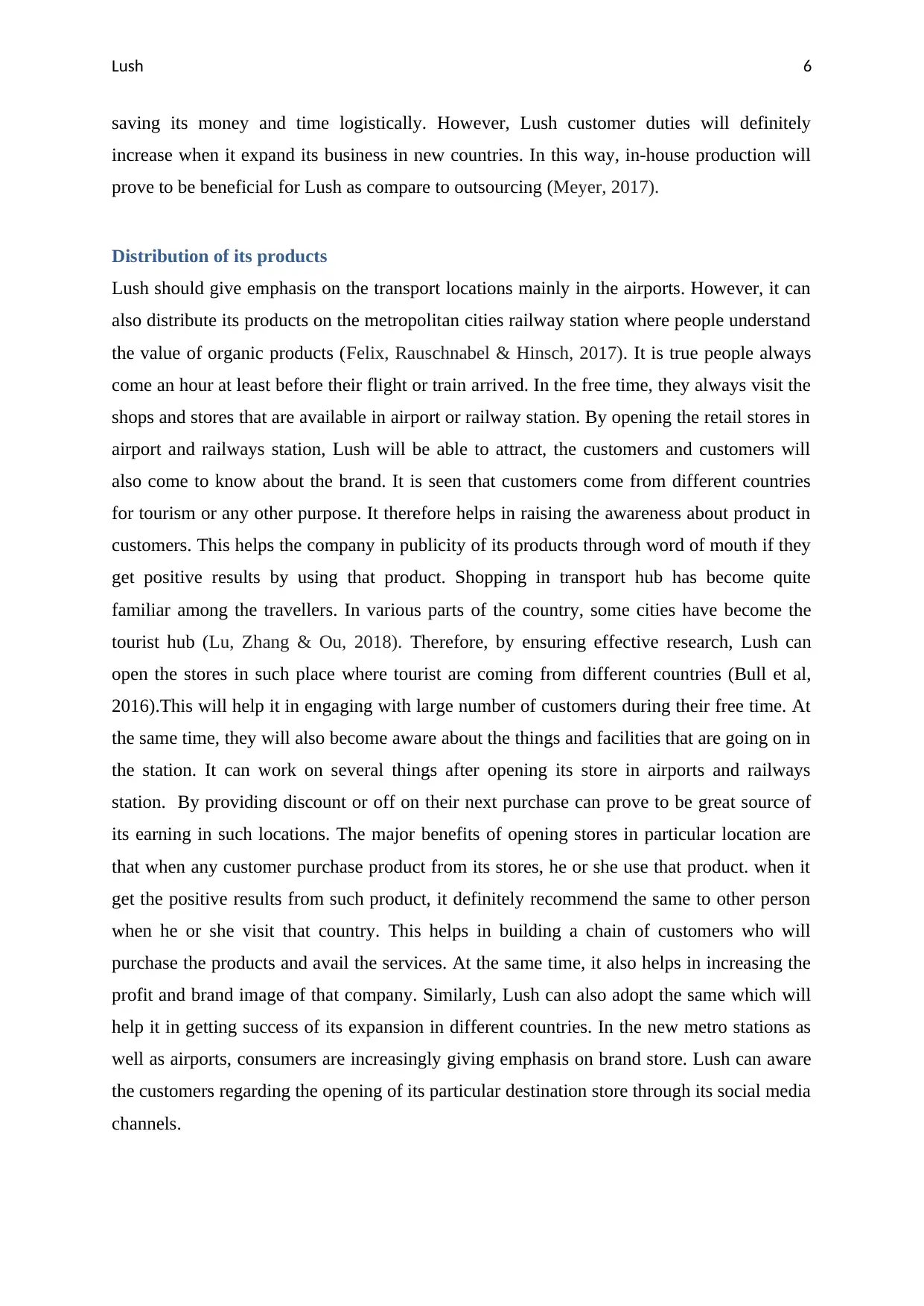
Lush 6
saving its money and time logistically. However, Lush customer duties will definitely
increase when it expand its business in new countries. In this way, in-house production will
prove to be beneficial for Lush as compare to outsourcing (Meyer, 2017).
Distribution of its products
Lush should give emphasis on the transport locations mainly in the airports. However, it can
also distribute its products on the metropolitan cities railway station where people understand
the value of organic products (Felix, Rauschnabel & Hinsch, 2017). It is true people always
come an hour at least before their flight or train arrived. In the free time, they always visit the
shops and stores that are available in airport or railway station. By opening the retail stores in
airport and railways station, Lush will be able to attract, the customers and customers will
also come to know about the brand. It is seen that customers come from different countries
for tourism or any other purpose. It therefore helps in raising the awareness about product in
customers. This helps the company in publicity of its products through word of mouth if they
get positive results by using that product. Shopping in transport hub has become quite
familiar among the travellers. In various parts of the country, some cities have become the
tourist hub (Lu, Zhang & Ou, 2018). Therefore, by ensuring effective research, Lush can
open the stores in such place where tourist are coming from different countries (Bull et al,
2016).This will help it in engaging with large number of customers during their free time. At
the same time, they will also become aware about the things and facilities that are going on in
the station. It can work on several things after opening its store in airports and railways
station. By providing discount or off on their next purchase can prove to be great source of
its earning in such locations. The major benefits of opening stores in particular location are
that when any customer purchase product from its stores, he or she use that product. when it
get the positive results from such product, it definitely recommend the same to other person
when he or she visit that country. This helps in building a chain of customers who will
purchase the products and avail the services. At the same time, it also helps in increasing the
profit and brand image of that company. Similarly, Lush can also adopt the same which will
help it in getting success of its expansion in different countries. In the new metro stations as
well as airports, consumers are increasingly giving emphasis on brand store. Lush can aware
the customers regarding the opening of its particular destination store through its social media
channels.
saving its money and time logistically. However, Lush customer duties will definitely
increase when it expand its business in new countries. In this way, in-house production will
prove to be beneficial for Lush as compare to outsourcing (Meyer, 2017).
Distribution of its products
Lush should give emphasis on the transport locations mainly in the airports. However, it can
also distribute its products on the metropolitan cities railway station where people understand
the value of organic products (Felix, Rauschnabel & Hinsch, 2017). It is true people always
come an hour at least before their flight or train arrived. In the free time, they always visit the
shops and stores that are available in airport or railway station. By opening the retail stores in
airport and railways station, Lush will be able to attract, the customers and customers will
also come to know about the brand. It is seen that customers come from different countries
for tourism or any other purpose. It therefore helps in raising the awareness about product in
customers. This helps the company in publicity of its products through word of mouth if they
get positive results by using that product. Shopping in transport hub has become quite
familiar among the travellers. In various parts of the country, some cities have become the
tourist hub (Lu, Zhang & Ou, 2018). Therefore, by ensuring effective research, Lush can
open the stores in such place where tourist are coming from different countries (Bull et al,
2016).This will help it in engaging with large number of customers during their free time. At
the same time, they will also become aware about the things and facilities that are going on in
the station. It can work on several things after opening its store in airports and railways
station. By providing discount or off on their next purchase can prove to be great source of
its earning in such locations. The major benefits of opening stores in particular location are
that when any customer purchase product from its stores, he or she use that product. when it
get the positive results from such product, it definitely recommend the same to other person
when he or she visit that country. This helps in building a chain of customers who will
purchase the products and avail the services. At the same time, it also helps in increasing the
profit and brand image of that company. Similarly, Lush can also adopt the same which will
help it in getting success of its expansion in different countries. In the new metro stations as
well as airports, consumers are increasingly giving emphasis on brand store. Lush can aware
the customers regarding the opening of its particular destination store through its social media
channels.
Paraphrase This Document
Need a fresh take? Get an instant paraphrase of this document with our AI Paraphraser
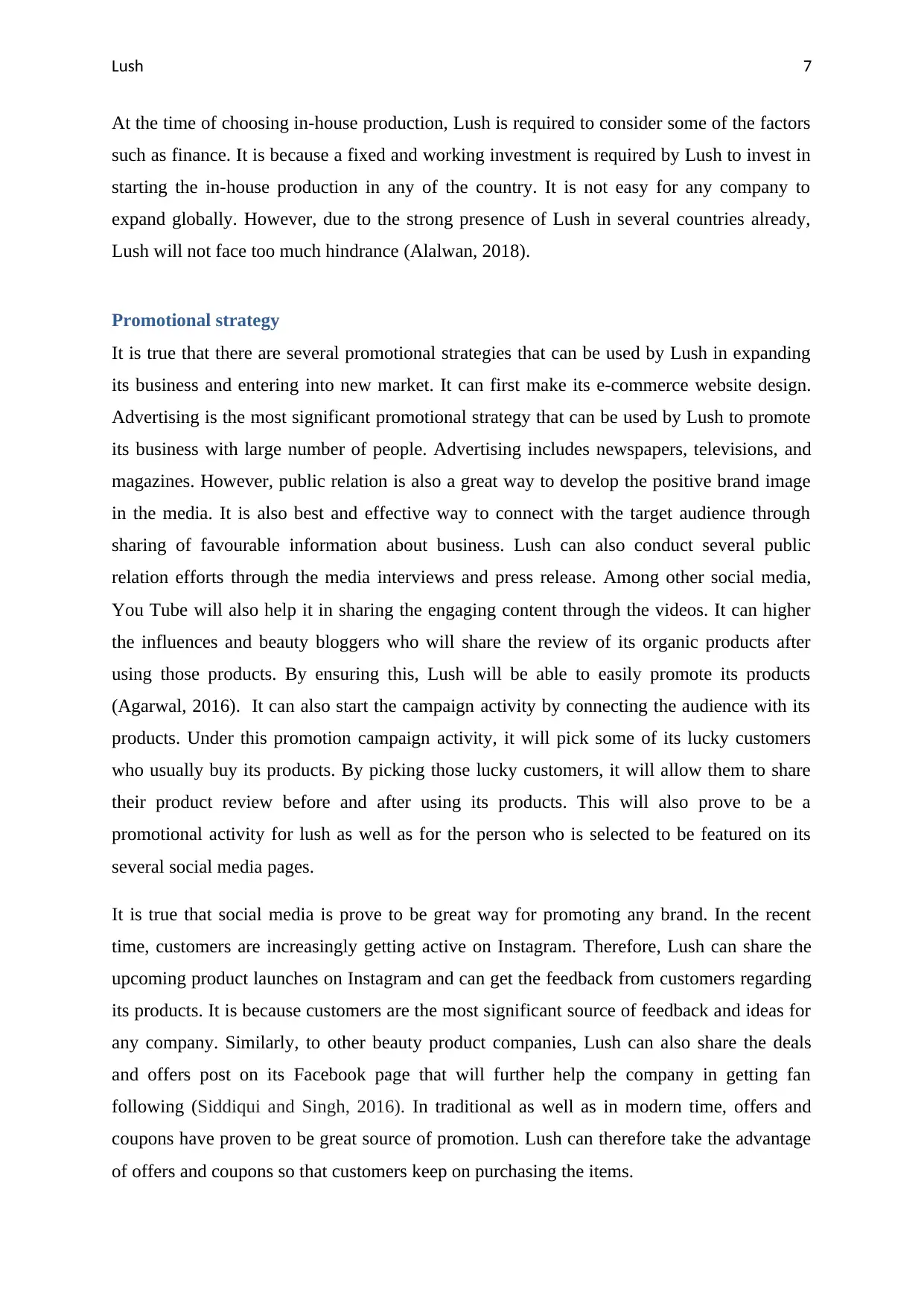
Lush 7
At the time of choosing in-house production, Lush is required to consider some of the factors
such as finance. It is because a fixed and working investment is required by Lush to invest in
starting the in-house production in any of the country. It is not easy for any company to
expand globally. However, due to the strong presence of Lush in several countries already,
Lush will not face too much hindrance (Alalwan, 2018).
Promotional strategy
It is true that there are several promotional strategies that can be used by Lush in expanding
its business and entering into new market. It can first make its e-commerce website design.
Advertising is the most significant promotional strategy that can be used by Lush to promote
its business with large number of people. Advertising includes newspapers, televisions, and
magazines. However, public relation is also a great way to develop the positive brand image
in the media. It is also best and effective way to connect with the target audience through
sharing of favourable information about business. Lush can also conduct several public
relation efforts through the media interviews and press release. Among other social media,
You Tube will also help it in sharing the engaging content through the videos. It can higher
the influences and beauty bloggers who will share the review of its organic products after
using those products. By ensuring this, Lush will be able to easily promote its products
(Agarwal, 2016). It can also start the campaign activity by connecting the audience with its
products. Under this promotion campaign activity, it will pick some of its lucky customers
who usually buy its products. By picking those lucky customers, it will allow them to share
their product review before and after using its products. This will also prove to be a
promotional activity for lush as well as for the person who is selected to be featured on its
several social media pages.
It is true that social media is prove to be great way for promoting any brand. In the recent
time, customers are increasingly getting active on Instagram. Therefore, Lush can share the
upcoming product launches on Instagram and can get the feedback from customers regarding
its products. It is because customers are the most significant source of feedback and ideas for
any company. Similarly, to other beauty product companies, Lush can also share the deals
and offers post on its Facebook page that will further help the company in getting fan
following (Siddiqui and Singh, 2016). In traditional as well as in modern time, offers and
coupons have proven to be great source of promotion. Lush can therefore take the advantage
of offers and coupons so that customers keep on purchasing the items.
At the time of choosing in-house production, Lush is required to consider some of the factors
such as finance. It is because a fixed and working investment is required by Lush to invest in
starting the in-house production in any of the country. It is not easy for any company to
expand globally. However, due to the strong presence of Lush in several countries already,
Lush will not face too much hindrance (Alalwan, 2018).
Promotional strategy
It is true that there are several promotional strategies that can be used by Lush in expanding
its business and entering into new market. It can first make its e-commerce website design.
Advertising is the most significant promotional strategy that can be used by Lush to promote
its business with large number of people. Advertising includes newspapers, televisions, and
magazines. However, public relation is also a great way to develop the positive brand image
in the media. It is also best and effective way to connect with the target audience through
sharing of favourable information about business. Lush can also conduct several public
relation efforts through the media interviews and press release. Among other social media,
You Tube will also help it in sharing the engaging content through the videos. It can higher
the influences and beauty bloggers who will share the review of its organic products after
using those products. By ensuring this, Lush will be able to easily promote its products
(Agarwal, 2016). It can also start the campaign activity by connecting the audience with its
products. Under this promotion campaign activity, it will pick some of its lucky customers
who usually buy its products. By picking those lucky customers, it will allow them to share
their product review before and after using its products. This will also prove to be a
promotional activity for lush as well as for the person who is selected to be featured on its
several social media pages.
It is true that social media is prove to be great way for promoting any brand. In the recent
time, customers are increasingly getting active on Instagram. Therefore, Lush can share the
upcoming product launches on Instagram and can get the feedback from customers regarding
its products. It is because customers are the most significant source of feedback and ideas for
any company. Similarly, to other beauty product companies, Lush can also share the deals
and offers post on its Facebook page that will further help the company in getting fan
following (Siddiqui and Singh, 2016). In traditional as well as in modern time, offers and
coupons have proven to be great source of promotion. Lush can therefore take the advantage
of offers and coupons so that customers keep on purchasing the items.
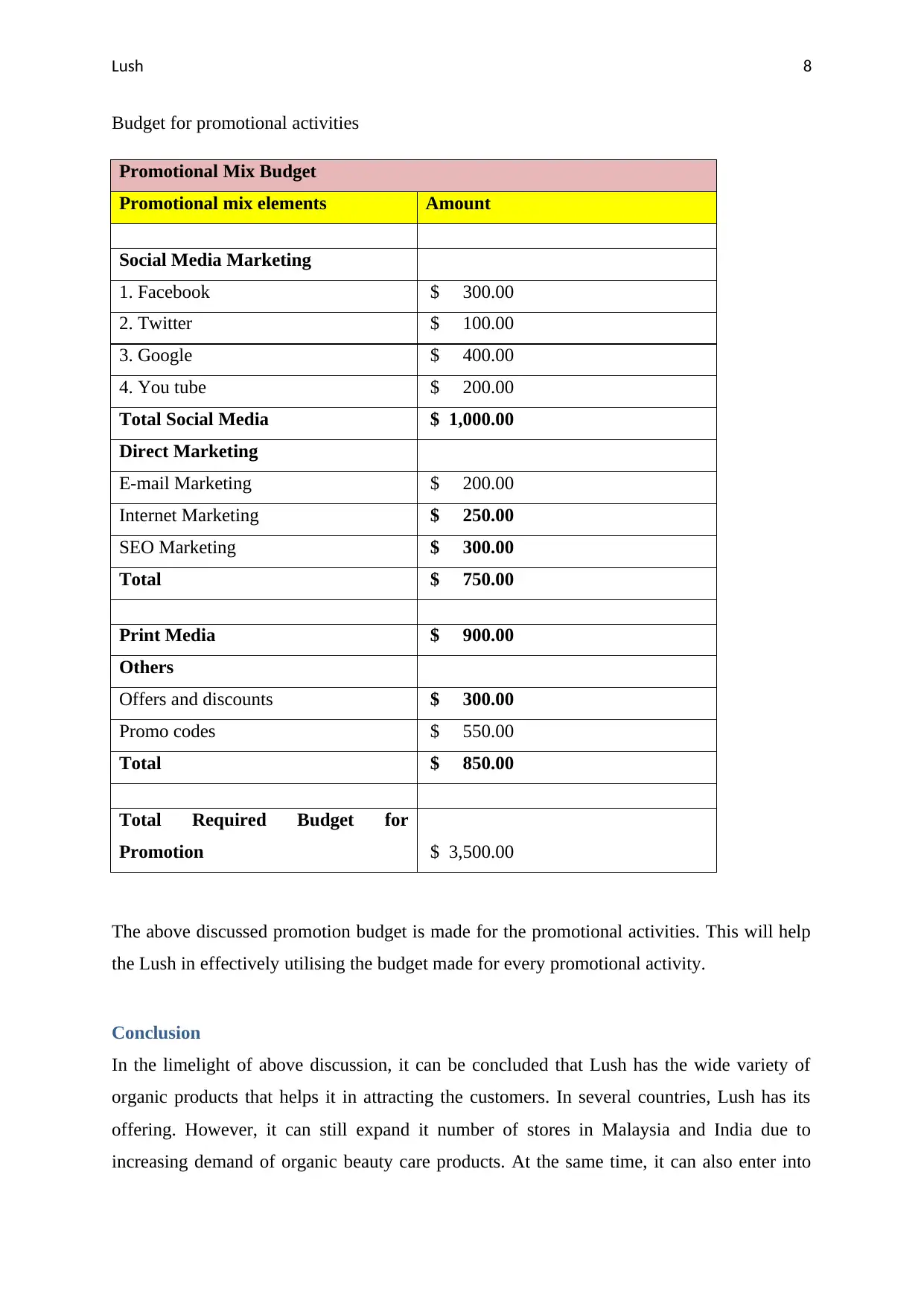
Lush 8
Budget for promotional activities
Promotional Mix Budget
Promotional mix elements Amount
Social Media Marketing
1. Facebook $ 300.00
2. Twitter $ 100.00
3. Google $ 400.00
4. You tube $ 200.00
Total Social Media $ 1,000.00
Direct Marketing
E-mail Marketing $ 200.00
Internet Marketing $ 250.00
SEO Marketing $ 300.00
Total $ 750.00
Print Media $ 900.00
Others
Offers and discounts $ 300.00
Promo codes $ 550.00
Total $ 850.00
Total Required Budget for
Promotion $ 3,500.00
The above discussed promotion budget is made for the promotional activities. This will help
the Lush in effectively utilising the budget made for every promotional activity.
Conclusion
In the limelight of above discussion, it can be concluded that Lush has the wide variety of
organic products that helps it in attracting the customers. In several countries, Lush has its
offering. However, it can still expand it number of stores in Malaysia and India due to
increasing demand of organic beauty care products. At the same time, it can also enter into
Budget for promotional activities
Promotional Mix Budget
Promotional mix elements Amount
Social Media Marketing
1. Facebook $ 300.00
2. Twitter $ 100.00
3. Google $ 400.00
4. You tube $ 200.00
Total Social Media $ 1,000.00
Direct Marketing
E-mail Marketing $ 200.00
Internet Marketing $ 250.00
SEO Marketing $ 300.00
Total $ 750.00
Print Media $ 900.00
Others
Offers and discounts $ 300.00
Promo codes $ 550.00
Total $ 850.00
Total Required Budget for
Promotion $ 3,500.00
The above discussed promotion budget is made for the promotional activities. This will help
the Lush in effectively utilising the budget made for every promotional activity.
Conclusion
In the limelight of above discussion, it can be concluded that Lush has the wide variety of
organic products that helps it in attracting the customers. In several countries, Lush has its
offering. However, it can still expand it number of stores in Malaysia and India due to
increasing demand of organic beauty care products. At the same time, it can also enter into
⊘ This is a preview!⊘
Do you want full access?
Subscribe today to unlock all pages.

Trusted by 1+ million students worldwide
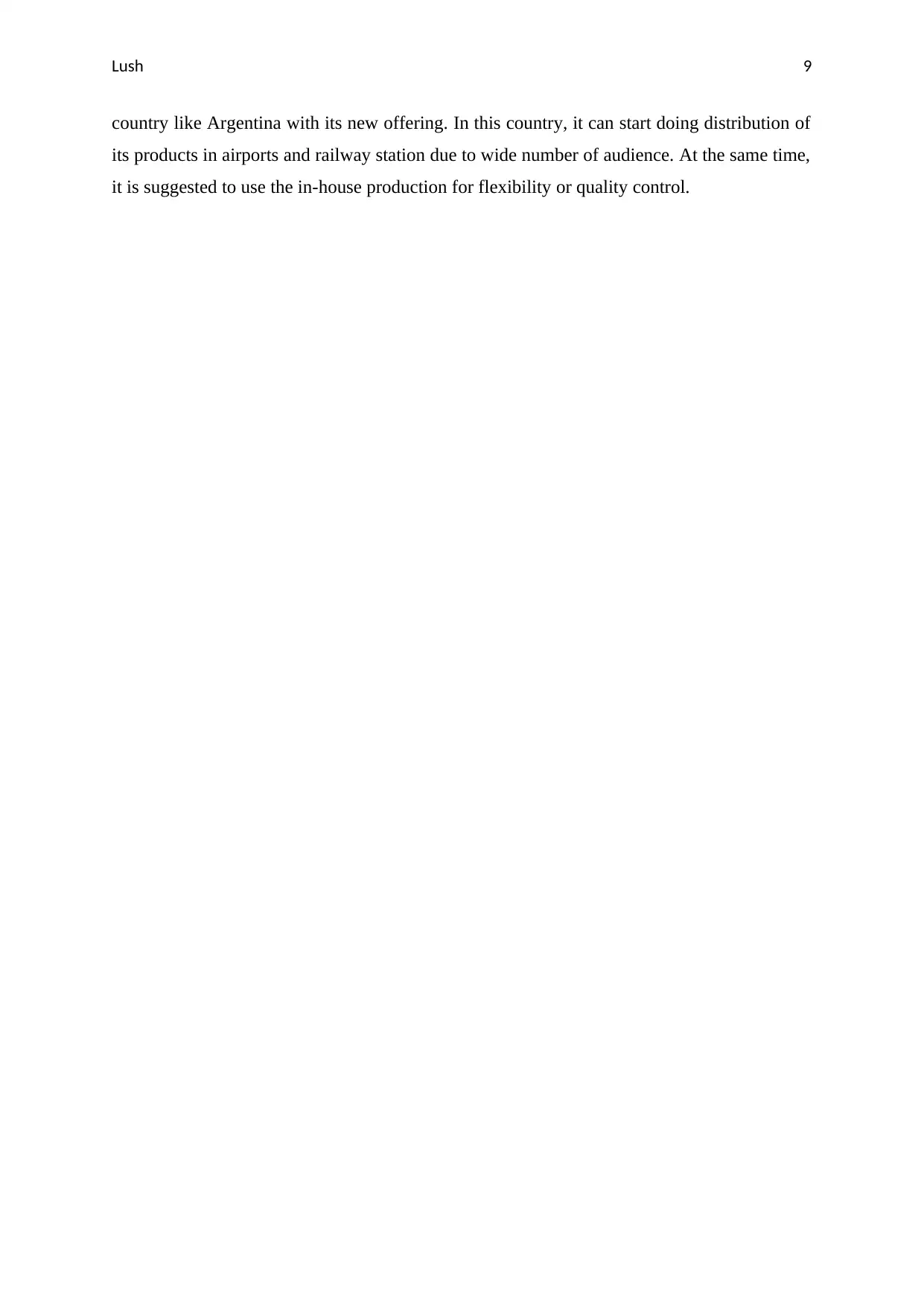
Lush 9
country like Argentina with its new offering. In this country, it can start doing distribution of
its products in airports and railway station due to wide number of audience. At the same time,
it is suggested to use the in-house production for flexibility or quality control.
country like Argentina with its new offering. In this country, it can start doing distribution of
its products in airports and railway station due to wide number of audience. At the same time,
it is suggested to use the in-house production for flexibility or quality control.
Paraphrase This Document
Need a fresh take? Get an instant paraphrase of this document with our AI Paraphraser
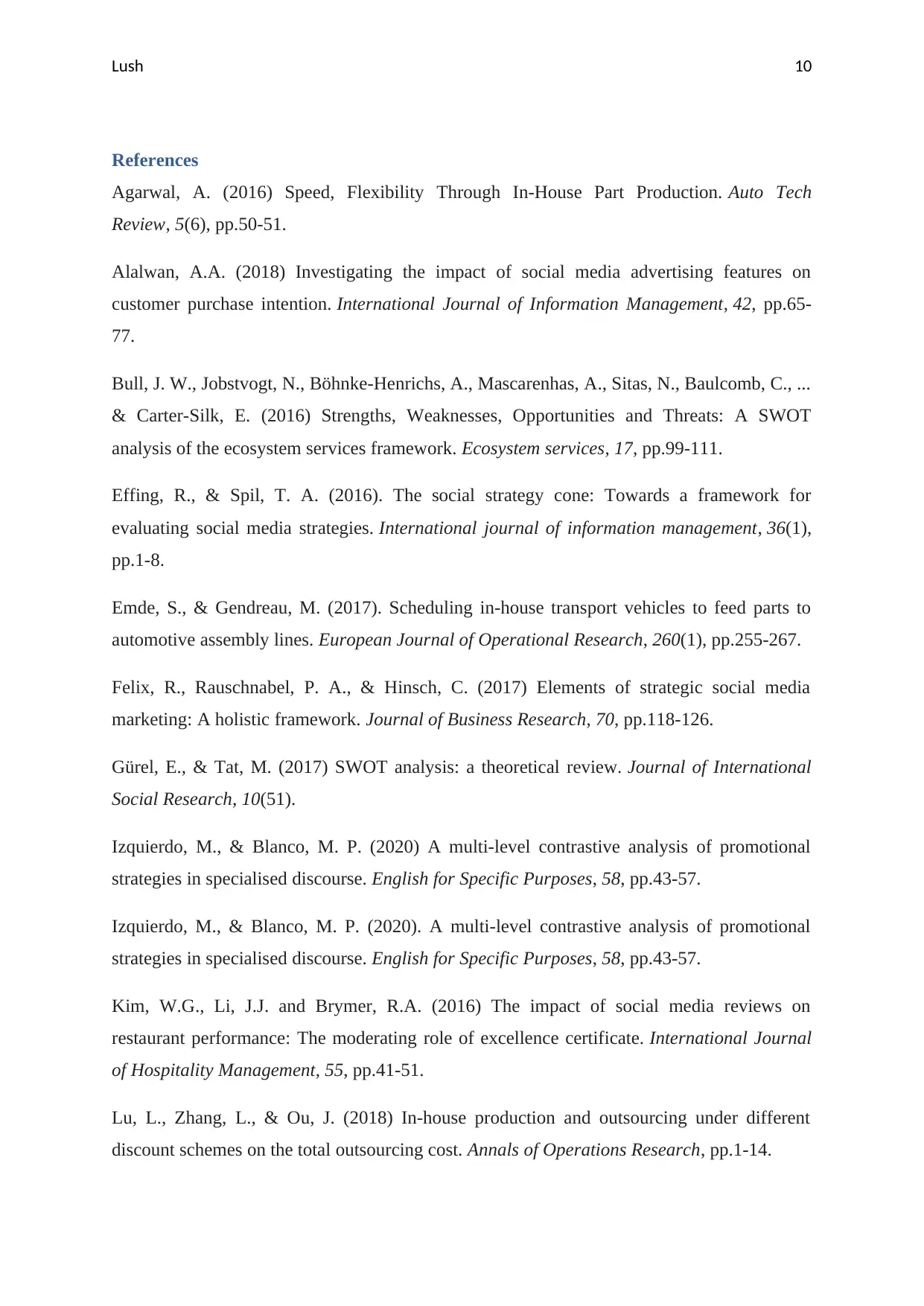
Lush 10
References
Agarwal, A. (2016) Speed, Flexibility Through In-House Part Production. Auto Tech
Review, 5(6), pp.50-51.
Alalwan, A.A. (2018) Investigating the impact of social media advertising features on
customer purchase intention. International Journal of Information Management, 42, pp.65-
77.
Bull, J. W., Jobstvogt, N., Böhnke-Henrichs, A., Mascarenhas, A., Sitas, N., Baulcomb, C., ...
& Carter-Silk, E. (2016) Strengths, Weaknesses, Opportunities and Threats: A SWOT
analysis of the ecosystem services framework. Ecosystem services, 17, pp.99-111.
Effing, R., & Spil, T. A. (2016). The social strategy cone: Towards a framework for
evaluating social media strategies. International journal of information management, 36(1),
pp.1-8.
Emde, S., & Gendreau, M. (2017). Scheduling in-house transport vehicles to feed parts to
automotive assembly lines. European Journal of Operational Research, 260(1), pp.255-267.
Felix, R., Rauschnabel, P. A., & Hinsch, C. (2017) Elements of strategic social media
marketing: A holistic framework. Journal of Business Research, 70, pp.118-126.
Gürel, E., & Tat, M. (2017) SWOT analysis: a theoretical review. Journal of International
Social Research, 10(51).
Izquierdo, M., & Blanco, M. P. (2020) A multi-level contrastive analysis of promotional
strategies in specialised discourse. English for Specific Purposes, 58, pp.43-57.
Izquierdo, M., & Blanco, M. P. (2020). A multi-level contrastive analysis of promotional
strategies in specialised discourse. English for Specific Purposes, 58, pp.43-57.
Kim, W.G., Li, J.J. and Brymer, R.A. (2016) The impact of social media reviews on
restaurant performance: The moderating role of excellence certificate. International Journal
of Hospitality Management, 55, pp.41-51.
Lu, L., Zhang, L., & Ou, J. (2018) In-house production and outsourcing under different
discount schemes on the total outsourcing cost. Annals of Operations Research, pp.1-14.
References
Agarwal, A. (2016) Speed, Flexibility Through In-House Part Production. Auto Tech
Review, 5(6), pp.50-51.
Alalwan, A.A. (2018) Investigating the impact of social media advertising features on
customer purchase intention. International Journal of Information Management, 42, pp.65-
77.
Bull, J. W., Jobstvogt, N., Böhnke-Henrichs, A., Mascarenhas, A., Sitas, N., Baulcomb, C., ...
& Carter-Silk, E. (2016) Strengths, Weaknesses, Opportunities and Threats: A SWOT
analysis of the ecosystem services framework. Ecosystem services, 17, pp.99-111.
Effing, R., & Spil, T. A. (2016). The social strategy cone: Towards a framework for
evaluating social media strategies. International journal of information management, 36(1),
pp.1-8.
Emde, S., & Gendreau, M. (2017). Scheduling in-house transport vehicles to feed parts to
automotive assembly lines. European Journal of Operational Research, 260(1), pp.255-267.
Felix, R., Rauschnabel, P. A., & Hinsch, C. (2017) Elements of strategic social media
marketing: A holistic framework. Journal of Business Research, 70, pp.118-126.
Gürel, E., & Tat, M. (2017) SWOT analysis: a theoretical review. Journal of International
Social Research, 10(51).
Izquierdo, M., & Blanco, M. P. (2020) A multi-level contrastive analysis of promotional
strategies in specialised discourse. English for Specific Purposes, 58, pp.43-57.
Izquierdo, M., & Blanco, M. P. (2020). A multi-level contrastive analysis of promotional
strategies in specialised discourse. English for Specific Purposes, 58, pp.43-57.
Kim, W.G., Li, J.J. and Brymer, R.A. (2016) The impact of social media reviews on
restaurant performance: The moderating role of excellence certificate. International Journal
of Hospitality Management, 55, pp.41-51.
Lu, L., Zhang, L., & Ou, J. (2018) In-house production and outsourcing under different
discount schemes on the total outsourcing cost. Annals of Operations Research, pp.1-14.
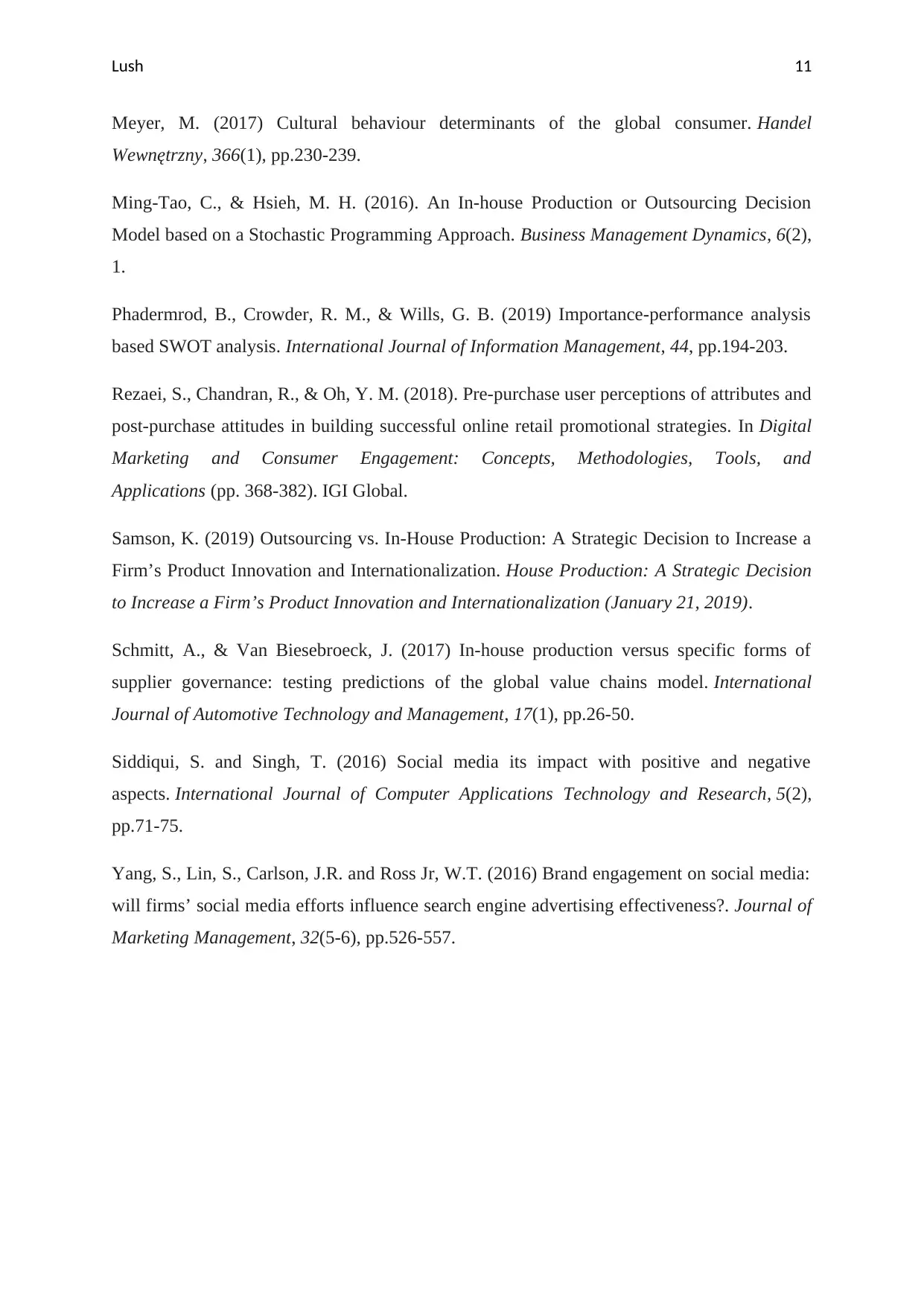
Lush 11
Meyer, M. (2017) Cultural behaviour determinants of the global consumer. Handel
Wewnętrzny, 366(1), pp.230-239.
Ming-Tao, C., & Hsieh, M. H. (2016). An In-house Production or Outsourcing Decision
Model based on a Stochastic Programming Approach. Business Management Dynamics, 6(2),
1.
Phadermrod, B., Crowder, R. M., & Wills, G. B. (2019) Importance-performance analysis
based SWOT analysis. International Journal of Information Management, 44, pp.194-203.
Rezaei, S., Chandran, R., & Oh, Y. M. (2018). Pre-purchase user perceptions of attributes and
post-purchase attitudes in building successful online retail promotional strategies. In Digital
Marketing and Consumer Engagement: Concepts, Methodologies, Tools, and
Applications (pp. 368-382). IGI Global.
Samson, K. (2019) Outsourcing vs. In-House Production: A Strategic Decision to Increase a
Firm’s Product Innovation and Internationalization. House Production: A Strategic Decision
to Increase a Firm’s Product Innovation and Internationalization (January 21, 2019).
Schmitt, A., & Van Biesebroeck, J. (2017) In-house production versus specific forms of
supplier governance: testing predictions of the global value chains model. International
Journal of Automotive Technology and Management, 17(1), pp.26-50.
Siddiqui, S. and Singh, T. (2016) Social media its impact with positive and negative
aspects. International Journal of Computer Applications Technology and Research, 5(2),
pp.71-75.
Yang, S., Lin, S., Carlson, J.R. and Ross Jr, W.T. (2016) Brand engagement on social media:
will firms’ social media efforts influence search engine advertising effectiveness?. Journal of
Marketing Management, 32(5-6), pp.526-557.
Meyer, M. (2017) Cultural behaviour determinants of the global consumer. Handel
Wewnętrzny, 366(1), pp.230-239.
Ming-Tao, C., & Hsieh, M. H. (2016). An In-house Production or Outsourcing Decision
Model based on a Stochastic Programming Approach. Business Management Dynamics, 6(2),
1.
Phadermrod, B., Crowder, R. M., & Wills, G. B. (2019) Importance-performance analysis
based SWOT analysis. International Journal of Information Management, 44, pp.194-203.
Rezaei, S., Chandran, R., & Oh, Y. M. (2018). Pre-purchase user perceptions of attributes and
post-purchase attitudes in building successful online retail promotional strategies. In Digital
Marketing and Consumer Engagement: Concepts, Methodologies, Tools, and
Applications (pp. 368-382). IGI Global.
Samson, K. (2019) Outsourcing vs. In-House Production: A Strategic Decision to Increase a
Firm’s Product Innovation and Internationalization. House Production: A Strategic Decision
to Increase a Firm’s Product Innovation and Internationalization (January 21, 2019).
Schmitt, A., & Van Biesebroeck, J. (2017) In-house production versus specific forms of
supplier governance: testing predictions of the global value chains model. International
Journal of Automotive Technology and Management, 17(1), pp.26-50.
Siddiqui, S. and Singh, T. (2016) Social media its impact with positive and negative
aspects. International Journal of Computer Applications Technology and Research, 5(2),
pp.71-75.
Yang, S., Lin, S., Carlson, J.R. and Ross Jr, W.T. (2016) Brand engagement on social media:
will firms’ social media efforts influence search engine advertising effectiveness?. Journal of
Marketing Management, 32(5-6), pp.526-557.
⊘ This is a preview!⊘
Do you want full access?
Subscribe today to unlock all pages.

Trusted by 1+ million students worldwide
1 out of 13
Related Documents
Your All-in-One AI-Powered Toolkit for Academic Success.
+13062052269
info@desklib.com
Available 24*7 on WhatsApp / Email
![[object Object]](/_next/static/media/star-bottom.7253800d.svg)
Unlock your academic potential
Copyright © 2020–2025 A2Z Services. All Rights Reserved. Developed and managed by ZUCOL.





